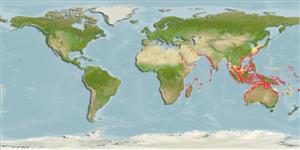Environment: milieu / climate zone / depth range / distribution range
Ecologia
marino associati a barriera corallina; distribuzione batimetrica 2 - 95 m (Ref. 55723), usually ? - 25 m (Ref. 42181). Tropical
Indo-West Pacific: East Africa to Papua New Guinea, north to Taiwan (Ref. 11441) and the Philippines, south to the Great Barrier Reef (Ref. 33390). Also reported from the Saya de Malha Bank (76-95 meters) (Ref. 55723).
Size / Peso / Age
Maturity: Lm ? range ? - ? cm
Max length : 25.0 cm TL maschio/sesso non determinato; (Ref. 48635)
Spine dorsali (totale): 12; Raggi dorsali molli (totale): 9; Spine anali 3; Raggi anali molli: 5. Adults are best recognized by the tiny light-blue ocelli scattered over the body, and dark triangle below the eye. Small juveniles have three distinctive white spots along the back (Ref. 48635). A deep quadrangular occipital pit, its anterior edge, as viewed dorsally, with a slight ridge. A low ridge on each side of pit between tympanic and parietal spines. Pectoral rays strongly modally at 17 (Ref 42181).
Inhabits coastal reefs (Ref. 9710); usually taken by diving in protected areas of bays or lagoons, often where the fish can be well camouflaged in areas of algae, seagrass or sponge (Ref. 42181, 48635). Venomous spines. Occurs along continental margins or islands associated with continents, not at true oceanic islands (Ref 90102).
Life cycle and mating behavior
Maturità | Riproduzione | Deposizione | Uova | Fecundity | Larve
Randall, J.E., G.R. Allen and R.C. Steene, 1990. Fishes of the Great Barrier Reef and Coral Sea. University of Hawaii Press, Honolulu, Hawaii. 506 p. (Ref. 2334)
IUCN Red List Status (Ref. 130435)
Human uses
Informazioni ulteriori
Nomi ComuniSinonimiMetabolismoPredatoriEcotossicologiaRiproduzioneMaturitàDeposizioneSpawning aggregationFecundityUovaEgg development
BibliografiaAcquacolturaProfilo di acquacolturaVarietàGeneticaElectrophoresesEreditarietàMalattieElaborazioneNutrientsMass conversion
CollaboratoriImmaginiStamps, Coins Misc.SuoniCiguateraVelocitàModalità di nuotoArea branchialeOtolithsCervelliVista
Strumenti
Special reports
Download XML
Fonti Internet
Estimates based on models
Preferred temperature (Ref.
123201): 24.5 - 29, mean 28 °C (based on 766 cells).
Phylogenetic diversity index (Ref.
82804): PD
50 = 0.5000 [Uniqueness, from 0.5 = low to 2.0 = high].
Bayesian length-weight: a=0.01259 (0.00606 - 0.02615), b=3.03 (2.86 - 3.20), in cm total length, based on LWR estimates for this (Sub)family-body shape (Ref.
93245).
Trophic level (Ref.
69278): 4.2 ±0.8 se; based on size and trophs of closest relatives
Resilienza (Ref.
120179): Medio, tempo minimo di raddoppiamento della popolazione 1.4 - 4.4 anni (Preliminary K or Fecundity.).
Fishing Vulnerability (Ref.
59153): Low vulnerability (15 of 100).
Nutrients (Ref.
124155): Calcium = 59 [31, 117] mg/100g; Iron = 0.683 [0.366, 1.639] mg/100g; Protein = 18 [16, 20] %; Omega3 = 0.223 [0.101, 0.607] g/100g; Selenium = 31.6 [17.1, 77.8] μg/100g; VitaminA = 201 [70, 540] μg/100g; Zinc = 1.22 [0.84, 1.75] mg/100g (wet weight);
